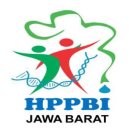Inventory of Macroscopic Fungi in Protected Forest Areas Malaka District Chartery
DOI:
https://doi.org/10.25134/quagga.v16i2.315Keywords:
Fungi Macroscopic, Characteristic, Inventory, Kateri ForestAbstract
Mushrooms are eukaryotic organisms with spores, without chlorophyll that reproduce sexually and asexually, mushrooms can be used by humans as food ingredients and ingredients for traditional and modern medicine. The purpose of this study was to determine the type and habitat characteristic of macroscopic fungi conducted in the kateri procted forest area Malaka Regency. Using exploration and identification methods where the plant identification process is a process of matching a plant according to a particular taxonomi on each research transect line. There are 28 species of macroscopic fungi namely Dacrymyces stilatus, Auricularia auricula-judae, Xylaria hypoxylon, Daldinia concentrica, Microporus xanthopus, Earliella scabrosa, Pycnoporus sanguineus, Polyporus alveolaris, Lentinus squarrosulus, Hexagonia tenuis, Trametes pubescens, Tyromyces chioneus, Marasmius oreades, Marasmius haematocephalus, Baespora myosura, Marasmius rotula, Marasmius andorsaceus, Trogia infundibiliformis, Leucocoprinus brebissonii, Lepiota helveola. Agaricus micromegathus, Bolbitius vitelinus, Mycena albicocapilaris, Crepidotus variabilis, Parasola plicatilis, Coprinopsis fragilisimus, Lycoperdon pyriforme, Pleurotus djamor. Divided into 5 Orders namely Dacrymycetales, Auriculariales, Xylariales, Polyporales, Agaricales. And 12 family namely Dacrymycetaceae, Auriculariaceae, Xylariaceae, Polyporaceae, Marasmiaceae, Agaricaceae, Bolbitiaceae, Mycenaceae, Crepidotaceae, Psathyrellaceae, Schizophyllaceae, Pleurotaceae. The most abundant habitat Characteristics were on rotten wood branches as many 9 species, on dead wood stem many as 8 species, in leaf little many as 4 species and in soil with hums many as 7 species.
References
Agus, GTK. (2002). Budidaya Jamur Konsumsi. Jakarta. Agro Media Pustaka. 68 hal.
Alexopoulos. (2007). Introductory mycology, 4th ed. John Wiley & Sons.
Alexopoulus, C. J., Blackwall, M., & Mims, C. W. 1996. Introductory mycology fourth edition. New York (US): John Wiley and Sons, Inc.
Anggraini, K, Khotimah, S & Turnip, M, 2015, ’Jenis-Jenis Jamur Makroskopis di Hutan Hujan Mas Desa Kawat Kecamatan Tayan Hilir Kabupaten Sanggau’, Jurnal Protobiont, vol.4, no.3, hal.60-64
BPS Kab.Malaka 2021. Profil Hutan Lindung Kateri 2017. Malaka. Badan pusat statistik Kabupaten Malaka.
BPS Provinsi. NTT Dalam angka tahun 2021, Badan Pusat Statistik hal. 9-113. Diakses tanggal 2 april 2021
Campbell, N.A., Reece, J.B., & Mitchell, L. G 2003. Biologi.Jilid 2. EdisiKelima. Ahli Bahasa:Wasmen. Jakarta: Penerbit Erlangga.
Darwis, W. 2011. Inventarisasi Jamur Yang Dapat Dikonsumsi Dan Beracun Yang Terdapat Di Hutan Dan Sekitar Desa Tanjung Kemuning Kaur Bengkulu. Konservasi Hayati, 7 (2). pp. 1- 8. ISSN 0216-9487
Florence, EJM & Yesodharan, K, 2000, ‘Macrofungal Flora of Peechi-Vazhani Wildlife Sanctuary’, Kerala Forest Research Institute
Gungor H dan solak M.H.2014.New crepidotus staude record for Turkish mycota 2014.Biological diversity and conversation. 127-128
Hall, I.R., Stephenson, S.L., Buchana, P.K., Yun W. dan Cole, A.L.J. 2003. Edible and poisonous mushrooms of the world. Cambridge, UK: Timber press
Hasanuddin. 2014. Jenis-Jamur Kayu Makroskopis Sebagai Media Pembelajaran Biologi (Studi di TNGL Blangjeran kabupaten Gayo Lues). Jurnal Biotik Vol. 2, No. 1.
Hasyiati, Rasma (2019) Keanekaragaman Jenis Jamur Kayu di Kawasan Pucok Krueng Alue Seulaseh sebagai Media Ajar dalam Pembelajaran Biologi di SMA Negeri 3 Aceh Barat Daya. Skripsi thesis, UIN Ar-Raniry Banda Aceh.
Hidayat, E. B. (1995). Anatomi tumbuhan berbiji.
Huffman, D. M., Tiffany, L. H., Knaphaus, G., & Healy, R. A. (2008). Mushrooms and other fungi of the Midcontinental United States. University of Iowa Press.
Kent. 2006. A Field Guide To Mushrooms North America. Hought Mifflin:
Lembaga ilmu pengetahuan Indonesia (LIPI). 2017. Berita biologi. Jurnal ilmu Hayati, 16 No 3.
Miller, Harapan H. 2006. Jamur amerika utara: panduan lapangan untuk jamur yang dapat dimakan dan jamur yang tidak dapat dimakan. Guilford, CN: FALCON Guide. P. 270 ISBN.
Nasution, F. 2018. Identifukasi Jenis Dan Habitat Jamur Makroskopis DiHutan Larangan Adat RumbioKabupaten Kampar Provinsi Riau. Wahana Forestra: Jurnal Kehutanan Vol. 13, No. 1
Onyango, B., Palapala, V., Arama, P., Wagai, S., & Gichimu, B. (2011). Suitability of selected supplemented substrates for cultivation of Kenyan native wood ear mushrooms (Auricularia auricula). American Journal of Food Technology, 6(5), 395-403. https://doi.org/10.3923/ajft.2011.395.403
Pardosi, L. Makin, F.M.P Wiguna, I.G.A. 2019. Ekplorasi Jamur Makroskopis Di Hutan Oeluan Kabupaten Timor Tengah Utara. Jurnal Sains Lahan Kering 3 (1) 4-6.
Rahma, K. 2018. Karakteristik Jamur Makroskopis di Perkebunan Kelapa Sawit
Shay JE. 2016. Biodevirsity and phylogeny of marasmius from Madagascar (Tesis). Faculty of sanfransisco state University.
Sudirman LM. 1995. Pemanfaatan Lentinus sp. Dalam Menunjang Industri Farmasi dan Pertanian. Agrotek, 2(2):55-59
Susan, D., & Retnowati, A. (2018). CATATAN BEBERAPA JAMUR MAKRO DARI PULAU ENGGANO: DIVERSITAS DAN POTENSINYA. BERITA BIOLOGI, 16(3). https://doi.org/10.14203/beritabiologi.v16i3.2939
Syafrizal, S. 2014. Inventarisasi Jamur Makroskopis Di Hutan Adat Kantuk Dan Implementasinya Dalam PembuatanFlipbook. [Skripsi]. Pontianak. Program Studi Pendidikan Biologi Jurusan Fmipa. Universitas Tanjungpura.
Sysouphanthong P, Hyde KD, Chukeatirote E dan Vellinga EC, 2011. A review of genus Lepiota and its distribution in Asia.Current research in Environmental dan Applied Mycology 1(2): 161-176
Tjokrokusumo, D. (2015). Diversitas jamur pangan terhadap kandungan beta-glukan dan manfaatnya terhadap kesehatan. https://doi.org/10.13057/psnmbi/m010646
Tyler G. 1991. Ecology of the genus mycena in beach (fagus sylvatica), oak (Quercus robur) and hornbean (carpinusbetulus) forest of Sweden.J. Bot. 111-121.
Wahyudi T.R, Rahayu S, Azwin. 2016. Keanekaragaman Jamur Basidiomycota Di HutanTropis Dataran Rendah Sumatera, Indonesia (StudiKasus Di Arboretum Fakultas Kehutanan Universitas Lancang Kuning Pekanbaru). Wahana Forestra: Jurnal Kehutanan.11, No.2.
Wardhani, H. A. (2023). Tumbuhan Obat Tradisional Suku dayak Tamambaloh Kabupaten Kapuas Hulu Kalimantan Barat. BIOSCIENTIAE, 20(1), 8. https://doi.org/10.20527/b.v20i1.6623
Winkler, D. (2008) Yartsa Gunbu (Cordyceps sinensis) and the Fungal Commodification of the Tibet’s Rural Economy. Economic Botany, 62, 291-305.
Wursten, B. (2009). Pycnoporus sanguineus. Diperoleh dari http://www.vumba-nature.com/Pycnoporus%20sanguineus.htm.
Yunida, N., Syamswisna, & Yeni, L. F. (2014). Inventarisasi Jamur Di Gunung Senujuh Kabupaten Sambas Dan Implementasinya Dalam Pembuatan Flash Card. Jurnal Pendidikan dan Pembelajaran Khatulistiwa, 3(10),https://dx.doi.org/10.26418/jppk.v3i10.7502
Downloads
Published
How to Cite
Issue
Section
License
Copyright (c) 2024 Lukas Pardosi, Natalia Hoar, Gergonius Fallo, I Gede Arya Wiguna

This work is licensed under a Creative Commons Attribution-ShareAlike 4.0 International License.




















